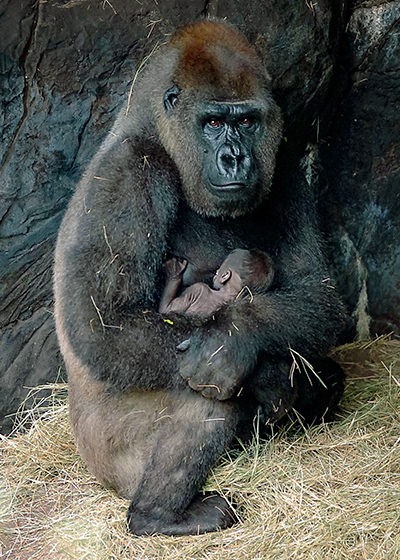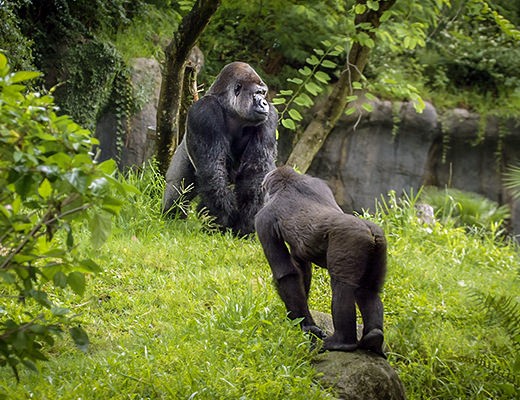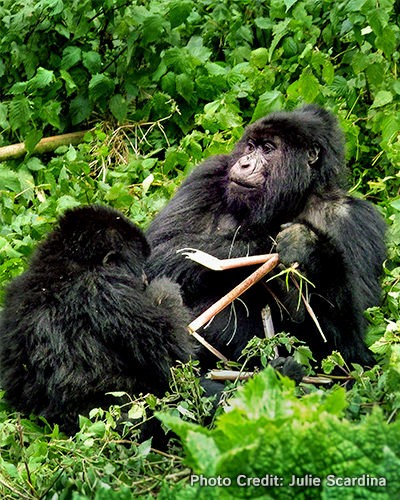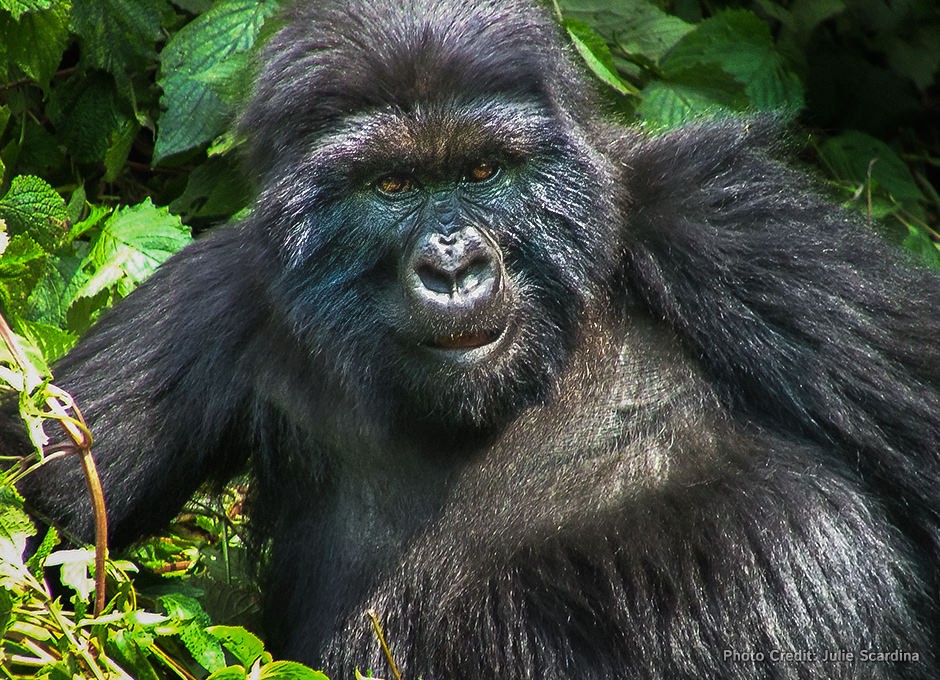Are you fascinated by gorillas and their way of life? If you’re planning a trip to see these magnificent creatures in the wild or just curious about their behavior, understanding their social structure is key. At SIXT.VN, we believe that informed travel enhances your experience, especially when exploring the wonders of Vietnam and beyond. Let’s explore the dynamics of gorilla groups, and you’ll gain a deeper appreciation for these incredible animals.
1. What Is the Typical Social Structure of Gorillas?
Yes, gorillas typically travel in groups, also known as troops. Gorilla troops generally consist of 2 to 30 individuals, but the average size is around 9. These troops often include one or more adult males (silverbacks), several adult females, juvenile males (black backs), and their offspring.
Understanding the social structure of gorillas helps us appreciate their complex behaviors. These troops are the foundation of their social lives, influencing everything from mating to protection. Let’s dive deeper into the dynamics of gorilla society.
1.1. The Role of the Silverback
The silverback is the dominant male in the troop, easily identified by the silver hair on his back, which indicates maturity. Typically, the oldest and strongest silverback leads the group.
- Leadership: The silverback makes crucial decisions, such as when and where to forage for food.
- Breeding Rights: He usually has exclusive breeding rights with the females in the troop, ensuring the continuation of his lineage.
- Protection: The silverback is responsible for the safety of the troop, defending them against threats and rivals.
- Mediation: Silverbacks often mediate conflicts within the group, maintaining order and stability.
This dominant role is critical for the survival and cohesion of the troop. Without a strong leader, the group would be vulnerable to external threats and internal strife.
1.2. The Role of Females
Adult females play a crucial role in the troop, focusing primarily on raising their young and maintaining social bonds.
- Motherhood: Mothers are closely bonded with their offspring for the first three years of life, providing constant care and protection.
- Social Hierarchy: The female’s rank within the troop is often determined by the order in which she joined, with earlier members receiving preferential treatment.
- Support: Females support the silverback in maintaining order and can assist in defending the troop against threats.
Females contribute to the troop’s stability by nurturing the next generation and reinforcing social connections.
1.3. The Role of Young Gorillas
Young gorillas, including juvenile males (black backs) and infants, learn essential survival skills within the troop.
- Learning: They observe and imitate the behaviors of older gorillas, learning how to find food, build nests, and interact socially.
- Development: Young males eventually leave their birth troop to form their own groups or join existing ones.
- Play: Play is an important part of their development, helping them build social skills and physical strength.
These young gorillas are the future of the troop, and their upbringing within the group is crucial for their successful integration into gorilla society.
2. How Do Gorillas Choose Their Group Members?
Gorillas do not simply choose their group members at random. Several factors influence who joins and remains in a troop, including age, relatedness, and the dynamics of power.
Understanding these factors can provide insights into the stability and longevity of gorilla groups.
2.1. Female Transfer and Troop Dynamics
Adolescent females typically transfer to another troop before they begin reproducing, usually around the age of 8.
- Avoiding Inbreeding: This transfer helps prevent inbreeding, ensuring genetic diversity within the gorilla population.
- Seeking Opportunity: Females often join a lone silverback or a newly formed troop to gain a higher status and better access to resources.
- Permanent Families: The first troop a female reproduces in generally becomes her permanent family, establishing long-term social bonds.
These transfers are critical for maintaining genetic health and social balance among gorilla populations.
2.2. Male Departure and Solitary Life
Adolescent males often leave their parent group due to a lack of breeding opportunities and the dominance of the silverback.
- Solitary Phase: These males often live solitary lives for several years as they mature and gain the strength needed to form their own troop.
- Forming New Troops: The process involves attracting females and establishing dominance over a territory.
- Competition: Competition for females and territory is fierce, leading to aggressive interactions between silverbacks.
This period of solitary life is a crucial step for young males to develop the skills and strength necessary to lead their own troops.
2.3. Troop Size and Composition
Troop sizes vary, typically ranging from 2 to 30 individuals, with an average of about 9. The composition of a troop can include multiple silverbacks, black backs, adult females, and young gorillas.
- Multiple Silverbacks: If a troop consists of multiple silverbacks, they are usually sons of the dominant male, creating a hierarchical structure.
- Large Troops: One of the largest gorilla troops ever identified included 4 silverbacks, 5 black backs, 12 adult females, and 16 young, highlighting the potential for large, complex social groups.
- Synchronization: Gorilla troops are highly synchronized in their activity patterns, moving, feeding, and resting together.
The size and composition of a troop reflect the complex social dynamics and available resources within their habitat.
 A dominant silverback gorilla sits peacefully amidst a lush green forest, surrounded by members of his troop.
A dominant silverback gorilla sits peacefully amidst a lush green forest, surrounded by members of his troop.
3. Why Is Group Travel Important for Gorillas?
Traveling in groups offers several benefits for gorillas, including protection from predators, access to resources, and social learning.
Understanding these advantages underscores the importance of group living for the survival and well-being of gorillas.
3.1. Protection from Predators
Living in a group provides enhanced protection from predators such as leopards.
- Increased Vigilance: Multiple individuals can watch for danger, increasing the chances of spotting threats early.
- Collective Defense: Silverbacks and other strong members of the troop can defend the group against predators.
- Safety in Numbers: The sheer size of the group can deter potential attackers.
This collective defense is essential for the survival of gorillas, especially for young and vulnerable members.
3.2. Access to Resources
Group travel allows gorillas to access a wider range of resources, such as food and territory.
- Foraging Efficiency: Troops can cover more ground, finding diverse food sources and ensuring everyone is well-fed.
- Territorial Defense: Groups can defend their home range against rival troops, securing access to essential resources.
- Knowledge Sharing: Older members of the troop can teach younger ones where to find food and water, improving their survival skills.
Access to resources is critical for the health and sustainability of the troop, and group travel enhances their ability to find and protect these resources.
3.3. Social Learning and Development
Living in a group provides opportunities for social learning and development, especially for young gorillas.
- Learning by Observation: Young gorillas learn essential skills by watching and imitating the behaviors of older members.
- Social Skills: They develop social skills through play and interaction, preparing them for their future roles within the troop.
- Cultural Transmission: Group living allows for the transmission of cultural knowledge, such as tool use and communication techniques.
Social learning is vital for the development of well-adjusted and capable gorillas, ensuring the continuation of their unique behaviors and traditions.
4. How Far Do Gorillas Travel in a Day?
Gorillas typically move about 400 to 1,000 meters (0.24 to 0.60 miles) per day. This distance can vary depending on factors such as food availability, terrain, and the presence of threats.
Understanding their daily travel patterns helps us appreciate their energy expenditure and the importance of conserving their habitat.
4.1. Factors Influencing Daily Travel Distance
Several factors influence how far gorillas travel each day.
- Food Availability: When food is abundant, gorillas may travel shorter distances since they don’t need to search as far.
- Terrain: Rugged or difficult terrain can slow them down, reducing their daily travel distance.
- Predator Presence: If there are nearby threats, gorillas may move more frequently to avoid danger.
- Social Dynamics: Internal conflicts within the troop can also affect their movement patterns.
These factors interact to determine the optimal travel distance for the troop each day.
4.2. Daily Activity Cycles
Gorillas spend a significant portion of their day feeding and resting.
- Feeding and Foraging: They spend about 14 hours feeding and foraging for food each day.
- Resting: Approximately 10 hours are spent resting, often during the hottest part of the day.
- Peak Activity: Feeding and foraging activity peaks during the first 3 to 4 hours of the day and resumes in the mid-to-late afternoon.
These daily cycles help gorillas balance their energy needs and maintain their health.
4.3. Nest Building
At the end of each day, gorillas construct nests to sleep in.
- Vegetation Gathering: They gather vegetation around them in trees or on the ground to create a comfortable sleeping space.
- New Nests: Gorillas construct a new nest each night because they travel to different locations while foraging.
- Parasite Avoidance: The daily construction of new nests helps avoid parasites that may nest in the bedding.
Nest building is an essential part of their daily routine, providing a safe and comfortable place to rest.
 A gorilla troop is gathered in a clearing, showcasing a silverback leading the way through the dense forest.
A gorilla troop is gathered in a clearing, showcasing a silverback leading the way through the dense forest.
5. What Role Does Territory Play in Gorilla Group Dynamics?
While gorillas are not strictly territorial in the sense of defending fixed boundaries, they do have home ranges that they utilize and protect.
Understanding the concept of home ranges helps us appreciate how gorillas interact with their environment and other troops.
5.1. Home Range Size
Gorilla troops have a home range that typically spans between 4 to 25 square kilometers (1.5 to 9.7 square miles).
- Resource Availability: The size of the home range depends on the availability of food and other resources.
- Troop Size: Larger troops may require larger home ranges to meet their needs.
- Overlapping Ranges: Home ranges can overlap with those of other troops, leading to potential conflicts.
The size of the home range is a critical factor in determining the sustainability of the troop.
5.2. Interactions with Other Troops
When gorilla troops encounter each other, interactions can range from peaceful to aggressive.
- Avoidance: Troops may avoid each other to prevent conflicts.
- Displays of Dominance: Silverbacks may engage in displays of dominance to assert their authority and protect their troop.
- Aggressive Encounters: In some cases, encounters can escalate into physical confrontations, especially over access to resources or mates.
These interactions shape the social landscape of gorilla populations and influence their movement patterns.
5.3. Defending Resources
Although gorillas are not strictly territorial, they will defend resources within their home range.
- Food Sources: Silverbacks will protect access to important food sources, ensuring their troop has enough to eat.
- Mating Opportunities: Competition for females can lead to aggressive encounters between silverbacks.
- Safe Sleeping Sites: Troops will defend safe and comfortable nesting sites from rivals.
Protecting these resources is essential for the survival and well-being of the troop.
6. How Do Silverbacks Maintain Order Within the Group?
Silverbacks maintain order within the troop through a combination of physical dominance, social signaling, and protective behaviors.
Understanding these methods provides insight into the leadership role of the silverback and the stability of the troop.
6.1. Physical Dominance
The silverback’s physical strength and imposing presence play a significant role in maintaining order.
- Size and Strength: Silverbacks are much larger and stronger than other members of the troop, allowing them to enforce their authority.
- Displays of Power: They use displays of power, such as chest-beating and charging, to intimidate rivals and maintain dominance.
- Intervention: Silverbacks will intervene in conflicts to prevent them from escalating and disrupting the troop.
Physical dominance is a key factor in establishing and maintaining the silverback’s leadership.
6.2. Social Signaling
Silverbacks use various social signals to communicate their status and intentions.
- Vocalizations: They use a range of vocalizations, such as grunts, barks, and screams, to communicate with other members of the troop.
- Body Language: Posture, facial expressions, and gestures convey important social information.
- Grooming: The silverback receives grooming from other members of the troop, reinforcing his status and social bonds.
These social signals help maintain clear lines of communication and reduce the likelihood of conflicts.
6.3. Protective Behaviors
The silverback’s role as protector of the troop is crucial for maintaining order.
- Defense Against Threats: He defends the troop against predators and rival groups, ensuring their safety.
- Conflict Resolution: Silverbacks mediate conflicts within the troop, preventing them from escalating and disrupting social harmony.
- Resource Management: He ensures that all members of the troop have access to food and other essential resources.
By providing protection and managing resources, the silverback earns the respect and loyalty of the troop.
7. What Happens When a Silverback Is Challenged?
Challenges to a silverback’s leadership are a natural part of gorilla social dynamics, often leading to intense confrontations and changes in troop structure.
Understanding these challenges provides insight into the complex power dynamics within gorilla society.
7.1. Types of Challenges
Challenges to a silverback’s leadership can come from within or outside the troop.
- Internal Challenges: Younger silverbacks within the troop may challenge the dominant male for leadership.
- External Challenges: Lone silverbacks may attempt to take over a troop, ousting the current leader.
- Indirect Challenges: Competition for mates or resources can also undermine the silverback’s authority.
These challenges can disrupt the stability of the troop and lead to significant changes in its structure.
7.2. Confrontations and Displays
When a silverback is challenged, confrontations often involve intense displays of power.
- Chest-Beating: Silverbacks will beat their chests to amplify their size and strength, intimidating their rivals.
- Vocalizations: Loud vocalizations, such as screams and roars, are used to assert dominance.
- Physical Fights: In some cases, confrontations can escalate into physical fights, resulting in injuries or even death.
These displays and confrontations are a crucial part of establishing dominance and determining the leadership of the troop.
7.3. Consequences of a Challenge
The consequences of a challenge can vary depending on the outcome.
- Successful Challenge: If the challenger is successful, they will take over leadership of the troop, potentially driving out or killing the former silverback.
- Unsuccessful Challenge: If the challenge is unsuccessful, the challenger may leave the troop or remain as a subordinate member.
- Troop Splitting: In some cases, a challenge can lead to the troop splitting into two separate groups.
These outcomes highlight the high stakes involved in challenging a silverback’s leadership.
 A younger male gorilla confronts a silverback, displaying aggressive behavior in a bid for dominance within the troop.
A younger male gorilla confronts a silverback, displaying aggressive behavior in a bid for dominance within the troop.
8. How Do Gorillas Communicate Within Their Groups?
Communication is essential for maintaining social bonds, coordinating activities, and resolving conflicts within gorilla groups.
Understanding their communication methods provides insight into the complex social lives of gorillas.
8.1. Vocalizations
Gorillas use a wide range of vocalizations to communicate with each other.
- Grunts: These are used to maintain contact and reassure other members of the troop.
- Barks: These are used as alarm calls to warn of danger.
- Screams: These are used to express fear or aggression.
- Roars: These are used to assert dominance and intimidate rivals.
Each vocalization serves a specific purpose, allowing gorillas to convey a wide range of information.
8.2. Body Language
Body language plays a crucial role in gorilla communication.
- Posture: Dominant gorillas will stand tall and upright, while subordinate gorillas will adopt a more submissive posture.
- Facial Expressions: Facial expressions, such as lip pursing and staring, can convey emotions and intentions.
- Gestures: Gestures, such as chest-beating and branch-breaking, are used to assert dominance and intimidate rivals.
Body language provides visual cues that complement vocalizations and enhance communication.
8.3. Tactile Communication
Tactile communication, such as grooming and touching, is essential for maintaining social bonds.
- Grooming: Grooming reinforces social bonds and helps remove parasites.
- Touching: Touching, such as embracing and patting, conveys reassurance and affection.
- Nose-to-Nose Greetings: Gorillas will often greet each other with nose-to-nose touching, reinforcing social connections.
Tactile communication strengthens social bonds and promotes harmony within the troop.
9. What Is the Impact of Human Activity on Gorilla Groups?
Human activities, such as habitat destruction, poaching, and disease transmission, have a significant impact on gorilla populations and their social structures.
Understanding these impacts is crucial for developing effective conservation strategies.
9.1. Habitat Destruction
Habitat destruction due to logging, agriculture, and mining reduces the availability of food and territory for gorillas.
- Reduced Home Ranges: Gorillas are forced to live in smaller areas, increasing competition for resources.
- Increased Conflict: Competition for resources can lead to increased conflict within and between troops.
- Disrupted Social Structures: Habitat destruction can disrupt social structures and lead to the breakdown of troops.
Protecting gorilla habitats is essential for their survival and well-being.
9.2. Poaching
Poaching for bushmeat and the illegal wildlife trade poses a significant threat to gorilla populations.
- Loss of Individuals: Poaching can result in the loss of key individuals, such as silverbacks and breeding females.
- Disrupted Social Structures: The loss of key individuals can disrupt social structures and lead to the breakdown of troops.
- Reduced Genetic Diversity: Poaching can reduce genetic diversity within gorilla populations, making them more vulnerable to disease and environmental changes.
Combating poaching is crucial for protecting gorilla populations and their social structures.
9.3. Disease Transmission
Human diseases, such as respiratory infections and Ebola, can have devastating effects on gorilla populations.
- High Mortality Rates: Gorillas are highly susceptible to human diseases, which can result in high mortality rates.
- Disrupted Social Structures: Disease outbreaks can disrupt social structures and lead to the breakdown of troops.
- Reduced Population Size: Disease outbreaks can significantly reduce population sizes, making gorillas more vulnerable to extinction.
Preventing disease transmission from humans to gorillas is essential for protecting their health and social structures.
 A mountain gorilla stares directly at the camera, highlighting the urgent need for conservation efforts.
A mountain gorilla stares directly at the camera, highlighting the urgent need for conservation efforts.
10. How Can I See Gorillas in Their Natural Habitat?
Seeing gorillas in their natural habitat is a unique and unforgettable experience. Several countries in Africa offer gorilla trekking tours, allowing you to observe these magnificent creatures up close.
Planning a gorilla trekking adventure requires careful consideration and preparation.
10.1. Countries Offering Gorilla Trekking
Several countries in Africa offer gorilla trekking tours.
- Rwanda: Known for its mountain gorillas and well-organized trekking experiences.
- Uganda: Offers both mountain and lowland gorilla trekking in various national parks.
- Democratic Republic of Congo: Provides opportunities to see lowland gorillas in less crowded environments.
Each country offers a unique experience, with varying levels of difficulty and accessibility.
10.2. Planning Your Trip
Planning a gorilla trekking trip requires careful consideration and preparation.
- Permits: You will need to obtain a permit, which can be expensive and must be booked in advance.
- Tour Operators: Choose a reputable tour operator with experience in gorilla trekking.
- Physical Fitness: Gorilla trekking can be physically demanding, so you should be in good shape.
- Health Precautions: Consult your doctor about necessary vaccinations and health precautions.
Proper planning is essential for a safe and enjoyable gorilla trekking experience.
10.3. Guidelines for Responsible Trekking
Responsible gorilla trekking is essential for minimizing your impact on these endangered animals.
- Maintain Distance: Keep a safe distance from the gorillas to avoid disturbing them.
- Follow Guidelines: Follow the guidelines provided by your guides to ensure the safety of both you and the gorillas.
- Respect Their Space: Respect their space and avoid making loud noises or sudden movements.
- Support Conservation: Support local conservation efforts by choosing eco-friendly tour operators and respecting local communities.
By following these guidelines, you can help protect gorillas and their habitat for future generations.
Understanding how gorillas travel in groups and their social dynamics enriches any wildlife encounter. Whether you are planning a trip to see these amazing creatures or simply expanding your knowledge, we hope this guide has been informative.
Planning a trip to Vietnam? Let SIXT.VN take the stress out of your travel arrangements. We offer reliable airport transfers, comfortable hotel bookings, exciting tour packages, and even flight bookings. With SIXT.VN, you can focus on enjoying your adventure while we handle the logistics. Contact us today to start planning your unforgettable journey. Let SIXT.VN be your trusted travel partner in Vietnam.
Address: 260 Cau Giay, Hanoi, Vietnam
Hotline/Whatsapp: +84 986 244 358
Website: SIXT.VN
FAQ About Gorilla Social Structure
Here are some frequently asked questions about gorilla social structure:
1. Are gorillas always led by a silverback?
Yes, gorillas are typically led by a dominant silverback male.
2. How do gorillas communicate with each other?
Gorillas communicate through vocalizations, body language, and tactile communication.
3. Do gorillas have territories?
Gorillas have home ranges, but they are not strictly territorial.
4. What is the average size of a gorilla troop?
The average size of a gorilla troop is around 9 individuals.
5. How far do gorillas travel in a day?
Gorillas typically travel between 400 and 1,000 meters per day.
6. What are the main threats to gorilla populations?
The main threats to gorilla populations include habitat destruction, poaching, and disease transmission.
7. How can I see gorillas in their natural habitat?
You can see gorillas in their natural habitat by booking a gorilla trekking tour in countries like Rwanda, Uganda, and the Democratic Republic of Congo.
8. What should I do if I encounter gorillas in the wild?
If you encounter gorillas in the wild, maintain a safe distance, follow the guidelines provided by your guides, and respect their space.
9. Why do female gorillas transfer to other troops?
Female gorillas transfer to other troops to avoid inbreeding and seek better access to resources.
10. What role do young gorillas play in the troop?
Young gorillas learn essential survival skills by observing and imitating the behaviors of older members of the troop.



